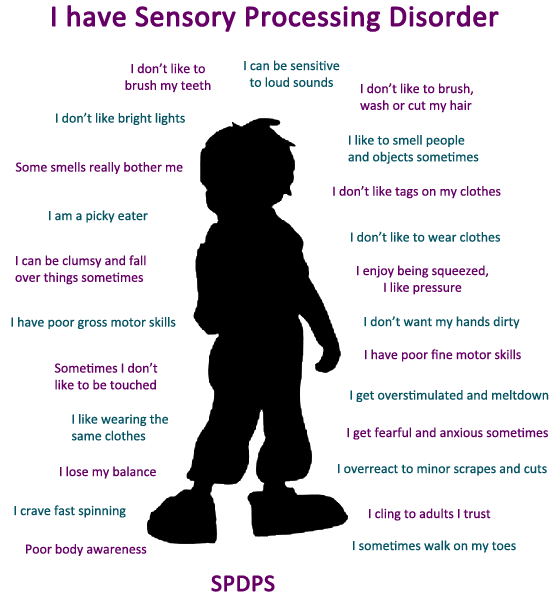What are the Signs of Sensory Processing Disorder?

Sensory Processing Disorder (SPD) is a neurological condition that influences how individuals interpret and respond to sensory information.
Distinct from conventional sensory impairment, like blindness or deafness, SPD is not about having limited senses.
Instead, it’s about the inaccurate perception or interpretation of sensory information, leading to difficulty with coordination, balance, and other essential life skills.
Known also as Sensory Integration Dysfunction, this encompassing condition can paradoxically lead to over or under-responsiveness to sensory inputs.
While some children might find normal clothing textures unbearable or experience a typical school canteen cacophony as painful, several others might remain undeterred by extreme temperatures, or simply tumble over at the slightest change in ground elevation because they have issues integrating multiple sensory signals.
Recognizing sensory processing disorder early is pivotal, given that it impacts children predominantly and that neurological plasticity reduces with age.
When accurately diagnosed and addressed, it enables these individuals to receive the necessary support, interventions, and accommodations, making the school and home environments more conducive to their needs.
With SPD, the symptoms largely depend on which type of sensory input is problematic.
Some children may be oversensitive to things in their environment. They may find loud noises terrifying. Others may have an extremely high pain threshold.
There might be challenges related to fine motor skills, balance, and coordination. SPD manifests itself in numerous ways, demonstrating the importance of understanding what the common signs are.
The following will delve into the telltale signals often associated with Sensory Processing Disorder, elucidating how childhood sensory problems can present themselves across various domains.
Sensitivities via sound, touch, and other forms of sensory stimuli will be examined, followed by reflection on the associated consequences of such disorders.
By conceptualizing SPD in this broader sense, we aim to equip you with the insights needed to recognize, understand, and aid those affected by it.
Understanding Sensory Processing Disorder
Definition and Prevalence
Sensory Processing Disorder, also known as Sensory Integration Dysfunction, refers to the brain’s difficulty in organizing and responding to information that comes in through the senses.
It is akin to a neurological traffic jam where certain parts of the brain are unable to receive sensory information needed to interpret sensory data correctly.
Statistics on how common SPD is
Studies suggest this disorder affects around 5%-16% of school-aged children, bridging across all social classes, ethnicities, and geographical locations.
Its signs often begin in early childhood, with some children outgrowing their symptoms. However, for an estimated 1 in 20 children, the signs of SPD persist into adolescence and even adulthood.
Factors Contributing to SPD
Genetic
While the exact cause of Sensory Processing Disorder is still unknown, current research points to several potential factors.
One hypothesis is that genetics play a key role in the development of SPD, given its higher prevalence in children with a family history of the disorder.
Studies also suggest a correlation between SPD and premature birth or low birth weight, indicating the potential role of early life stressors in the disorder’s onset.
Enivronmental Inlfuences
Environmental influences are also thought to be contributing factors.
For instance, children exposed to certain toxins during critical periods of brain development may be at a higher risk for SPD.
However, it is essential to note that these factors may influence SPD’s development and not necessarily cause it directly.
Other potential causes
The role of other potential causes, like diet, allergies, and even childhood vaccination, has been the subject of much debate.
While there is a lack of definitive research evidence linking these factors to SPD, it is a rapidly evolving field requiring further exploration.
Medical Community’s Perspective on SPD
Current research data
While research on Sensory Processing Disorder has increased considerably over the past few decades, the understanding of SPD in the medical community is still evolving.
Part of the confusion arises from the subtle and often disguised signs of the disorder; often, children with SPD are misdiagnosed with other conditions like ADHD or autism.
Views on SPD diagnosis
Current data suggests that SPD is likely a distinct neurological condition, but some medical professionals argue that SPD is a symptom of other developmental disorders rather than a standalone condition.
This dynamic has led to inconsistent diagnoses and treatment approaches among practitioners.
Treatment approaches
As for treatment, there are numerous approaches to manage Sensory Processing Challenges.
Sensory integration therapy, in particular, has shown significant promise.
This form of therapy involves occupational therapists creating customized activities that help the child respond appropriately to stimuli in a fun and meaningful environment.
In addition to therapy, many experts recommend creating a sensory-friendly environment both at home and school, along with implementing a sensory diet plan.
These strategies can help to avoid Sensory Overload Disorder, and help children learn to cope with sensory stimuli in a manner most comfortable to them.
The debate about SPD’s precise nature and treatment in the medical community underscores the importance of further research in this area.
Expanding our understanding of SPD will enable us to develop better diagnostic tools and more effective intervention strategies, enhancing the quality of life for those dealing with Sensory Processing Issues.
Common Signs of SPD

Behaviors Indicating Sensory Overload
Extreme reactions to sensory inputs
In individuals with Sensory Overload Disorder, a subtype of Sensory Processing Disorder, ordinary sensory stimuli are perceived as overwhelming, leading to extreme reactions.
The constant feeling of being flooded with too much information can trigger anxiety, distress, and fear in individuals.
For example, a child may have an intense adverse reaction to everyday sounds, smells, or touch, which indicates Sound Sensitivity Disorder or Touch Sensitivity Disorder.
They may struggle with ordinary textures in clothing, and need to avoid specific fabrics that are typical for most people.
Frequent emotional meltdowns
These high levels of sensory sensitivity can lead to frequent emotional meltdowns.
Such tantrums or emotional outbursts are often inexplicable to an outside observer but are the child’s way of coping with Sensory Processing Challenges.
Difficulty performing routine tasks
Also, routine tasks that need multi-sensory integration, like getting dressed, eating, or even participating in a group activity, can be exceedingly strenuous for these kids, leading to avoidance or fussiness.
Signs Showing Sensory Under-stimulation
Photo by Thomas Park on Unsplash
Lack of response to sensory inputs
On the other end of the spectrum, some individuals have a reduced or absent response to sensory inputs, a condition known as Hypo-responsiveness Disorder.
These individuals appear indifferent or oblivious to stimuli that others might find painful or irritating.
Certain sounds, temperatures, or physical touch that would trigger a reaction in most children will not unsettle them.
Uncoordinated movements
In the absence of the necessary sensory feedback, they might display uncoordinated movements or clumsy behavior and find tasks, like buttoning a shirt or tying shoelaces, challenging.
Unusual posture or movements
This sensory denial can lead to unusual posture or movements.
They might be seen leaning heavily on certain objects or people, adopt odd positions to feel more secure, or even inflict self-harm to procure some sensory stimulation.
Other Indirect Symptoms Indicating SPD
Sleeping and eating problems
Apart from these direct sensory processing issues, SPD can manifest itself in indirect ways, further complicating the detection process.
For instance, children may experience sleep disturbances due to their heightened senses.
The tick-tocking of a clock or the rustling of sheets, for instance, might drastically affect a child’s ability to fall asleep or stay asleep.
Eating problems are also common among children with SPD, with many exhibiting specific or restricted food preferences.
This issue usually stems from their heightened senses to the textures, tastes, or smells of certain foods.
Social difficulties
SPD can also impact a child’s social interactions, making it difficult for them to form and maintain relationships with their peers.
They might struggle with interpreting social situations appropriately or feel overwhelmed in social settings, leading them to retreat or act out aggressively.
Difficulty learning at school
Moreover, the school environment, with its multitudes of stimuli and pressure on multi-sensory integration, can be particularly challenging for these kids.
Classroom noise, a myriad of visual inputs, physical proximity to others, or the textural feel of paper and craft materials can be overwhelming or even unbearable.
While the signs mentioned above are often seen in individuals with SPD, it’s essential to realize that any single sign does not confirm the presence of Sensory Processing Disorder.
If you note several symptoms that persist over time, it would be a good idea to consult a healthcare professional for a comprehensive evaluation.
How to Respond to SPD Symptoms
What Parents Should Do If They Suspect SPD
Observations to make
If you suspect your child may be dealing with Sensory Processing Issues, the first step is observing and documenting their behaviors.
Keep a record of your child’s reactions to different sensory experiences and any challenging situations.
This documentation can provide valuable insight to healthcare professionals later on.
Professionals to consult
Consultation with experts, such as pediatricians, psychologists, and occupational therapists, will shed more light on the sensory challenges your child might be facing.
These professionals are equipped to analyze your child’s behavior and sensory responses, eventually diagnosing if it is indeed Sensory Integration Dysfunction or another related disorder.
Enhancements at home or at school
If an SPD diagnosis is made, modifications in the child’s environment, both at home and school, might be suggested.
This could mean damping sensory stimuli, adding certain sensory experiences, or even offering breaks during tasks that require prolonged sensory integration.
Recognizing their sensory comfort zones and gradually exposing them to their triggers helps to facilitate adaptive responses.
Educational Adjustments to Help SPD Children
Adapted school routines
Children with Sensory Processing Disorder often need accommodations in their schooling. Providing an adapted routine that respects their sensory needs can help these children better manage their sensory experiences.
This might mean allowing the child to take more frequent breaks, assigning locker spaces away from noisy areas, or providing headphones for sound sensitive children.
Specialized learning aids
The use of specialized learning aids can also be beneficial. Tools such as weighted vests, fidget toys, or cushioned seating can help improve sensory integration and increase focus.
Teachers and school officials should be informed about the child’s SPD so they can promote a conducive learning environment, respecting the child’s sensory needs.
Importance of a supportive environment
Promoting a supportive and tolerant environment at school is crucial for these children.
Children with Sensory Processing Disorder can often feel isolated due to their unique sensory experiences.
Helping peers understand these sensory integration difficulties can foster empathy and acceptance, significantly improving the child’s social experience.
Medical and Therapeutic Interventions
Therapies available for SPD
Several therapies are available for addressing SPD. Occupational therapy, particularly with a sensory integration approach, is often suggested.
This method encourages the child to engage in physical activities that are designed to adjust the way the brain responds to touch, movement, sight, and sound.
Role of medication
While medications do not cure SPD, they can be instrumental in managing some coexisting conditions, such as ADHD or anxiety.
Any medication should be given under the strict guidance of a healthcare provider. It’s also crucial to continually monitor and assess the child’s response to the medication.
How to measure treatment success
Success in treatment isn’t just about the absence of certain behaviors. Instead, it’s about making growth in several areas, such as improved performance in daily tasks, better coping strategies, increased self-confidence, and enhanced quality of life.
Recognizing these improvements will help to monitor the progress, adapt the treatment plan, and celebrate every small victory along this journey.
In conclusion, while dealing with Sensory Processing Disorder can be challenging both for the child and the caregivers, understanding the disorder, seeking timely help, making necessary interventions, and continually advocating for the child can lead to significant improvements.
Remember that you are not alone on this journey and that help is available.
By taking one step at a time, you can improve your child’s sensory experience, making the world a less overwhelming place for them.
Wrapping Up Sensory Processing Disorder
In addressing the question, “What are the signs of Sensory Processing Disorder?”, we dove into the intricacies of this complex disorder and how it can impact those who live with it.
Often manifesting in childhood, SPD entails a unique set of challenges characterized by the brain’s difficulties in processing sensory inputs.
These may range from extreme reactions to sensory inputs, such as sounds and touch, reflecting conditions like Sound Sensitivity Disorder or Touch Sensitivity Disorder, to a lack of response to such inputs, indicating Hypo-responsiveness Disorder.
Despite these challenges, there is hope. If you suspect your child has SPD, observing and documenting their behavior will be a critical first step, followed by seeking professional consultation.
It’s important to emphasize that an early diagnosis followed by appropriate interventions, such as sensory integration therapy and adaptations in the child’s physical environment, can significantly enhance their well-being and progress.
Although the disorder can profoundly influence a child’s life, it doesn’t define their entire existence.
Schools can make adjustments in routine and provide specialized learning aids, enabling them to navigate their educational journey.
Medical professionals can guide families towards useful therapies and interventions, and in certain cases, aid with suitable medications.
We’d like to extend reassurance to all parents and caregivers dealing with the distinct realities of Sensory Processing Disorder.
Although the journey can feel overwhelming at times, remember that you are not alone, and there is a wealth of support available.
With awareness, understanding, patience, and professional guidance, children with SPD can lead fulfilling lives, overcoming barriers and flourishing in their unique ways.
Keep in mind that each child is unique and coping mechanisms that work for one child may not be as effective for another.
The recognition and celebration of these idiosyncrasies are vital steps towards fostering a more compassionate and nurturing environment for all.
The fact that you’re seeking understanding about SPD already makes you a champion in your child’s eyes. It takes courage to accompany your child on this journey.
Together, stride by stride, you and your child can navigate this world filled with sensory experiences.


